Want a gorgeous garden fast? Use this time at home to plant your best garden that will turn your neighbour’s green with envy.
Whether you’re an urban transplant new to gardening or just want instant gratification, now is the time to think about fast-growing, pleasure-giving plants, vines and hedges that will make it look like you and your garden go way back. Here’s how to fill to thrill with a slew of varieties that grow in one season, replacing eyesores with beauty while expanding the greenery in your garden to new heights. Read more, ‘Key Outdoor Trends To Make The Most of Your Garden All Year.’
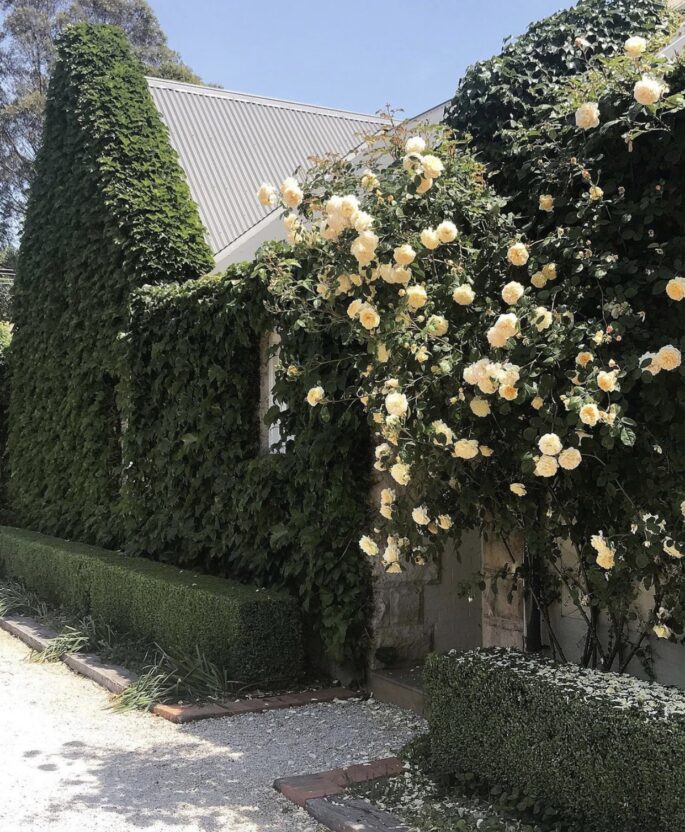
Melissa’s green thumb in full swing at her country house where exterior walls are clad in fast-climbing, well-behaved Boston ivy.
Stroll and ‘steal’
Walk around your neighbourhood to see what grows well in your soil and climate. Ask neighbours whether certain plants flourish. Visit local public gardens and nurseries, ideally where the plants are identified. Read more, ‘How To Improve Your Outdoor Space.’
Make a list of what you like and copy shamelessly.
Buy small in the fall
Young plants and trees that aren’t full yet grow quicker than bigger versions because they can focus their energy on the roots. Trees can’t grow until they establish their root systems, and larger trees can perish if that takes too long. Besides, older plants just cost more. Read more, ‘Making a Modern Garden.’
Simulate ‘old’ paths
For quick and elegant hardscaping that doesn’t look too new, lay gravel and pebble walkways that meander through your garden. If you add a fence or wall, tuck a fast-climbing plant alongside so it will look like it’s been there a while. Read more, ‘Your First Garden: How To Start A Garden For Practically Nothing.’
We recommend English or Boston ivy, star Jasmine or climbing hydrangea.
Fill to thrill
Because you have to leave space for three- to five-year growth when you plop plants in the ground, arriviste gardens give themselves away. Fill the offending gaps with container plants. Use well-draining, frost-proof pots made of stone, iron, steel, or heavy plastic. See below for strategies on container gardening and what to plant. Read more, ‘Designing A Garden? You’ll Need a Plan.’
Springtime
Early-blooming bulbs brighten any outdoor space. (It’s not a bad idea to ask the previous owner where bulbs are already planted.) Plant them close to paths, driveways and windows. Easy ornamental grasses fill holes like instant hair implants. Treat them badly. All you have to do is get the grasses established and leave them alone. You don’t have to prune them until they start pushing new growth in the spring, so you can enjoy their glory.

Rapidly extending vines make a wall disappear in this garden. Image via @travel_magical.
20 FAST-GROWING PLANTS, VINES AND CLIMBERS
Rusty chain link fence got you down? Tumbledown compost heap turned into an eyesore? Need to make the neighbours’ amateur backyard auto repair shop disappear? Gardeners know the quickest, most politic way to solve those problems is almost always a bushy, rapidly extending vine. Not only will it curtain off the ugliness, it also will replace an eyesore with beauty while expanding the greenery in your garden to new heights. Here are 20 fast-growing plants, vines and hedges for those in a hurry. We have an unapologetic love of vines (even those that some despise for their invasive nature).
BOSTON IVY
It’s a well-behaved climber that’s a sensible alternative to ivy, and a perennial climbing vine that is gentler on masonry and an even more vigorous grower (its reach can top nine metres at maturity). Its deciduous nature means that its foliage cloaks a facade in coolness during summer months.
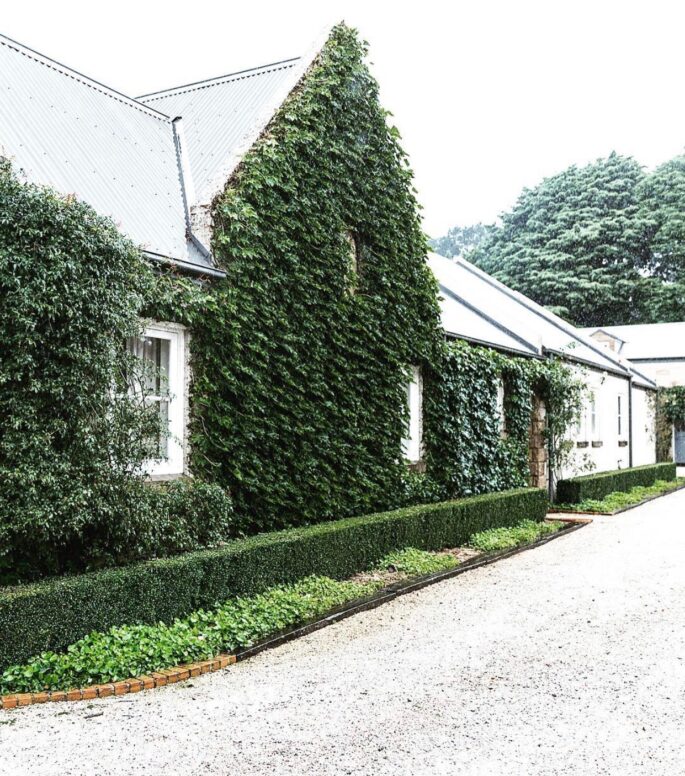
Melissa’s Country House features an entire exterior side wall of Boston ivy – a perennial climbing vine and vigorous grower (its reach can top nine metres at maturity).
CREEPING FIG
This evergreen climber’s rapid growth can make it invaluable as a ground cover and a reliable concealer of ugly fences and walls. But others decry its sometimes out-of-control spread and its unfortunate ability to damage some of the surfaces it clings to. It will climb over virtually anything, it’s important to note that it attaches itself to topiary forms or fences (or your neighbour’s garage) via a powerful gum-like adhesive that can destroy some surfaces including wood and mortar and makes the vine virtually impossible to remove. Because of its unusually rapid growth, creeping fig should be pruned frequently both to remove the horizontal stems and to keep it under control generally.

Creeping Fig – the evergreen climber’s rapid growth can make it invaluable as a reliable concealer of ugly walls. Image via Gardenista.
VIRGINIA CREEPER
Virginia creeper is a deciduous vine with much to recommend it that will grow quickly to cover an unattractive wall and attach itself with aerial tendrils and adhesive pads (instead of roots). It won’t damage mortar or a facade, but its vigorous growth habit has earned it the dubious moniker of “invasive” that can choke less aggressive plants and overwhelm a tree canopy if not kept in check.
Its vigorous growth can quickly reach a height of 15 metres.
MORNING GLORY
An excellent option for times when you need an extremely fast-growing creeper or climber to hide a wall or other eyesore in the garden. The vine has handsome heart-shaped leaves and delicate trumpet flowers and is easy to grow (reaching heights of up to 4.5 metres in a single season). Use it to mask a trouble spot in the garden—such as an unsightly fence or wall—and prevent it from turning into an invasive pest (deadhead flowers before it sets seed pods).
STAR JASMINE
A vigorous woody climber that can top out at 12 metres the voracious growth and strong aroma of Star Jasmine with hangs over our terrace is a twining, evergreen,perennial that grows as a vine. Yes, you have to cut it vigorously.
Yes, it is worth every snip.
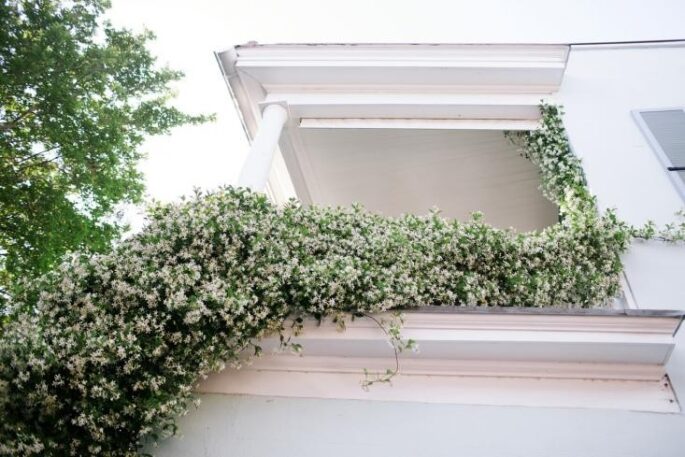
Star Jasmine climbing is a fast-growing, twining, evergreen,perennial with a strong, heady scent. Photograph:Olivia Rae James.
PASSIONFRUIT VINE
Passion vine can solve many problems in a landscape with its robust foliage and unforgettable blooms. Like a strategically placed dab of concealer on the face, vigorous fast-growing vines are ideal for growing on walls, fences, and trellises and can quickly beautify a garden while mitigating almost any fault. It will probably grow fast enough over one season to give you good coverage and provide a satisfying flower display. It can easily grow 6 metres or more a year.
Prune the vines in the early spring to control growth, promote lush foliage, and increase flower and fruit production.
BOUGAINVILLEA
The sun lover, that comes in all sizes, will provide a pretty pop of colour against a back fence, garden shed or pergola.
CLIMBING HYDRANGEA
The tall-climbing woody vine attaches itself, usually, to masonry walls – and incredible when they bloom, like a tall tree attached to the house with beautiful side-branches sticking out with their huge white flower clusters.
It is a slow to start, but vigorous once in bloom.
HEDERA IVY
Commonly known as ivy, this classic species of the evergreen vine is adept at climbing vertically up practically any surface or as a ground cover. Ivy will grow in almost any soil that is not waterlogged.
RAMBLER ROSES
They tend to grow faster than climbers and they like to sprawl. Their stems are more pliable than climbers’ and easier to weave through open fences and trellises. While a climber may be coaxed into repeat blooming, a rambler generally will perform only once a year.
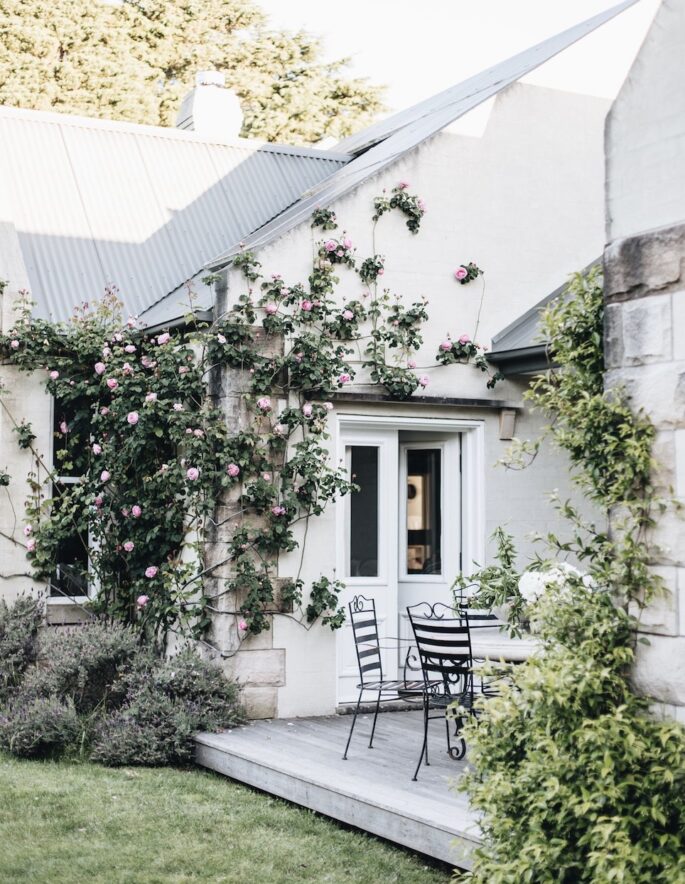
Rambling roses cloak the wall at Melissa’s country house. They tend to grow faster than climbers and like to sprawl.. Photo:Abbie Melle
WISTERIA
A classic climber with fast-growing vines and flowers that camouflage unsightly architecture or beautifully ornament a patio roof or passageway. Being deciduous, wisteria provides summer shade and winter sun. It will clothe surfaces with an opulent spread of thickly clustered flowers and should be planted in spring or autumn, with from three to four metres of space per plant to ensure they don’t choke out the rest of your garden.
NASTURTIUM VINES
Fast-growing nasturtium vines are great multitaskers in your garden: they’re edible, beautiful, and trail down walls, spillover window boxes and scramble over paths.
DWARF LILLY PILLY
Lillypillies are often used as hedges and for good reason. They grow quickly, have a naturally dense habit with glossy green smallish leaves, attractive new growth and colourful fruit that’s often edible. They respond well to a regular light trim or an occasional hard cut back. They grow up to 1.8 metres in 12 to 18 months.
ORANGE BLOSSOM
This stunning hedge grows to around three metres high, although it can grow as high as five metres. It will reach up to 1.8 metres (standard fence height) in under three years in a warm, temperate climate.
It flowers two or more times a year with richly fragrant white flowers.

Vines will expand the greenery in your garden taaking it’s beauty to new heights. Image via @meetmyproject.
COSMOS
Cosmos is a prolific bloomer with a long season, which many gardeners grow as a reliable cut flower. It is useful anywhere you plant it in a flower border, where it will fill late summer holes, with varieties in a range of heights and colours but white is prettiest.
SNOWBALLS
Viburnums appear on every landscape designer’s list of must-haves. The native shrub bursts with creamy white flower clusters in late spring, growing up to two feet a year and as large as 4.5 metres by 4.5 metres. It is like the perfect string of pearls: a simple and classic detail that makes any outfit feel complete.
No matter the season, this fast-growing flowering shrub usually thrives, produces showy white blossoms and luscious foliage giving your garden an elegant finishing touch, like throwing on just the right piece of jewellery as you’re leaving the house. Because viburnum doesn’t self-pollinate regularly, plant several viburnum shrubs near each other.
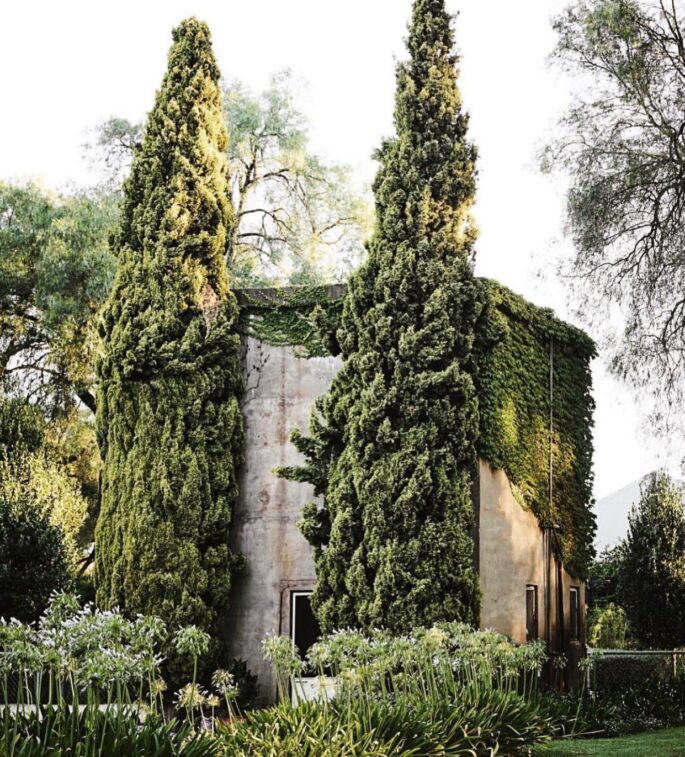
Fast-growing leylandii conifers are an excellent screeming plant or trimmed into a hedge. Image via @melissa_penfold.
LEIGHTON GREEN LEYLANDII
This is a fast-growing conifer, excellent as a screening plant or trimmed into a hedge. It has a very dense-forming habit and can reach heights of more than 5m in 10 years and can grow to more than 15m. Not for small gardens, unless you have time to keep it at a smaller size.
SASANQUA CAMELLIA:
These beauties come in a range of sizes, and can grow up to five metres tall, with glossy green leaves and masses of gorgeous flowers in Spring. They grow up to 1.8 metres in under three years in a warm, temperate climate.
Make Container Gardening Work for You
Planting flowers in pots is the quickest way to get started in gardening. Here are several strategies to keep container plants thriving. It is much easier than creating a bed in the lawn and requires less maintenance. If you live in an apartment or have a tiny yard, it may be your only option.
But like most things in gardening, there can be bumps. Use the wrong pot or the wrong soil, water too little or too much, and the plants can suffer.
One of the biggest hurdles with container gardening is preventing the plants from drying out. A container in strong sun can bake the poor things like an oven. Unlike flowers in a bed, the heat surrounds the roots on all sides.

Container gardening is about picking the right pot. Bigger is better. Don’t skimp on quantity. You want the arrangement to look abundant. Image via @melissa_penfold.
Here are several strategies to keep container plants thriving, plus tips on what to plant:
Pick the right pot: Bigger is better
More soil gives the roots more room to expand. More soil also holds more water. More soil gives the roots more room to expand. More soil also holds more water. Avoid traditional unglazed terra cotta pots. They lack coatings, and the moisture seeps right out. Instead, go for glazed pottery, metal urns or the newer fiberglass, resin or composite ones that can look remarkably like clay. And since waterlogged soil can be as bad for plants as desiccated soil, choose a pot with a drainage hole.
Avoid traditional unglazed terra cotta pots. They lack coatings, and the moisture.
Keep moisture in the soil:
To keep your plants hydrated, mix into the container soil moisture-retaining beads, sold under such brands as Soil Moist and Miracle-Gro Water Storing Crystals. They absorb water like a sponge and release it when the soil dries. After planting, cover the soil with an inch or two of mulch to keep moisture in. And buy a saucer to sit beneath the pot. It will catch excess water that the soil can suck up when it is parched.
Pick the right plants:
Limit the plant types and colours so they complement one another. It is easy to accidentally create a garish combo in a container since the plants intermingle. Stick to annuals, which tend to bloom on and off throughout the summer; perennials usually flower just a few weeks. Make sure all of the plants in one pot are either for sun or shade, depending on where you put the pot.
And don’t skimp on quantity. You want the arrangement to look abundant.
Arrange the plants logically:
The industry calls them thrillers, fillers and spillers: a tall, attention-getting plant in the centre surrounded by shorter flowers and vine-like plants dangling over the sides. Good thriller candidates are plants with dramatically variegated leaves. For fillers, try verbena. For spillers, petunias work fine, and are a classic look.
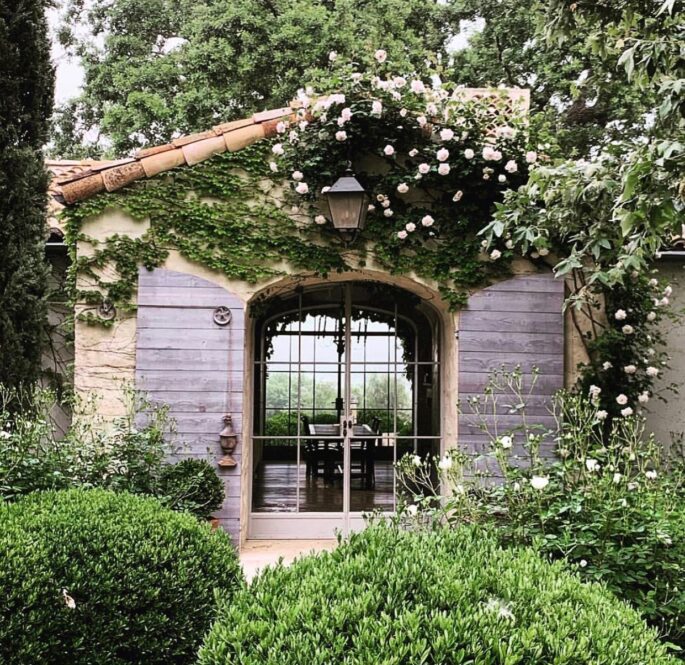
Patina Farm, designed by owners Brooke and Steve Giannetti.


